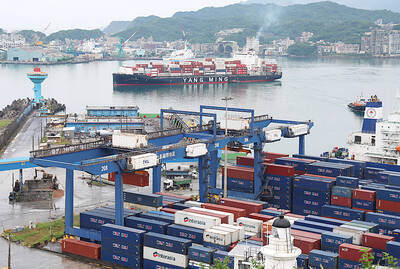The damage from the COVID-19 pandemic to economies in the Asia-Pacific region could reach US$2 trillion through next year, S&P Global Ratings said on Friday, as the coronavirus persists and the recovery of business conditions to pre-pandemic levels looks some way off.
The implementation of social distancing and other containment measures would continue in a bid to mitigate the effects of the outbreak until an effective vaccine is developed, but such practices will likely cause income losses for households and businesses, it said.
“As the COVID-19 pandemic endures, we are learning more about its human, economic and financial costs,” S&P Global Ratings Asia-Pacific chief economist Shaun Roache said in a statement. “The next lesson will be about the cost of transition between lockdown and vaccine.”

Photo: Chen Hsin-yu, Taipei Times
Economies in the region would enter a transition period until the middle of next year, during which social distancing measures would pervade in everyday life, although such constraints might differ by country and could be relaxed or tightened from time to time depending on the epidemic situation, the ratings agency said.
“Economic policies can limit some of the damage during first-wave containment, support the partial recovery through transition, and provide a bridge to the self-sustaining recovery that takes hold in late 2021. However, the costs continue to compound,” it added.
Based on S&P’s estimate, economic growth across the region would slow to 0.3 percent this year, which compares with 4.8 percent growth the agency forecast prior to the pandemic and marks the lowest since the 1.3 percent growth during the Asian financial crisis in 1997.
The IMF last week said that economic growth in the region will likely slow to a standstill this year, which has not happened in the past 60 years.
S&P said that Taiwan’s economy would shrink by 1.2 percent this year, down from its previous estimate of 1.9 percent expansion.
The ratings agency said it expects China’s economy to grow 1.2 percent, down from the 2.9 percent growth it projected earlier.
The agency cut its growth forecast for India from 3.5 percent to 1.8 percent and expects Japan’s economy to contract by 3.6 percent, compared with a decline of 1.2 percent it predicted earlier.
Governments in the region are facing imminent challenges, such as unemployment, from the pandemic, which would cause consumers to become more frugal, increase pressure on more leveraged households and take a toll on the broader economy, S&P said.
“From an economics perspective, the main risk now is unemployment,” Roache said. “Jobs are easily lost, but hard to win back and a surge in unemployment, say by more than 4 percentage points across the region, would mean a much flatter recovery path.”

CHIP RACE: Three years of overbroad export controls drove foreign competitors to pursue their own AI chips, and ‘cost US taxpayers billions of dollars,’ Nvidia said China has figured out the US strategy for allowing it to buy Nvidia Corp’s H200s and is rejecting the artificial intelligence (AI) chip in favor of domestically developed semiconductors, White House AI adviser David Sacks said, citing news reports. US President Donald Trump on Monday said that he would allow shipments of Nvidia’s H200 chips to China, part of an administration effort backed by Sacks to challenge Chinese tech champions such as Huawei Technologies Co (華為) by bringing US competition to their home market. On Friday, Sacks signaled that he was uncertain about whether that approach would work. “They’re rejecting our chips,” Sacks

Taiwan’s exports soared 56 percent year-on-year to an all-time high of US$64.05 billion last month, propelled by surging global demand for artificial intelligence (AI), high-performance computing and cloud service infrastructure, the Ministry of Finance said yesterday. Department of Statistics Director-General Beatrice Tsai (蔡美娜) called the figure an unexpected upside surprise, citing a wave of technology orders from overseas customers alongside the usual year-end shopping season for technology products. Growth is likely to remain strong this month, she said, projecting a 40 percent to 45 percent expansion on an annual basis. The outperformance could prompt the Directorate-General of Budget, Accounting and

NATIONAL SECURITY: Intel’s testing of ACM tools despite US government control ‘highlights egregious gaps in US technology protection policies,’ a former official said Chipmaker Intel Corp has tested chipmaking tools this year from a toolmaker with deep roots in China and two overseas units that were targeted by US sanctions, according to two sources with direct knowledge of the matter. Intel, which fended off calls for its CEO’s resignation from US President Donald Trump in August over his alleged ties to China, got the tools from ACM Research Inc, a Fremont, California-based producer of chipmaking equipment. Two of ACM’s units, based in Shanghai and South Korea, were among a number of firms barred last year from receiving US technology over claims they have

BARRIERS: Gudeng’s chairman said it was unlikely that the US could replicate Taiwan’s science parks in Arizona, given its strict immigration policies and cultural differences Gudeng Precision Industrial Co (家登), which supplies wafer pods to the world’s major semiconductor firms, yesterday said it is in no rush to set up production in the US due to high costs. The company supplies its customers through a warehouse in Arizona jointly operated by TSS Holdings Ltd (德鑫控股), a joint holding of Gudeng and 17 Taiwanese firms in the semiconductor supply chain, including specialty plastic compounds producer Nytex Composites Co (耐特) and automated material handling system supplier Symtek Automation Asia Co (迅得). While the company has long been exploring the feasibility of setting up production in the US to address